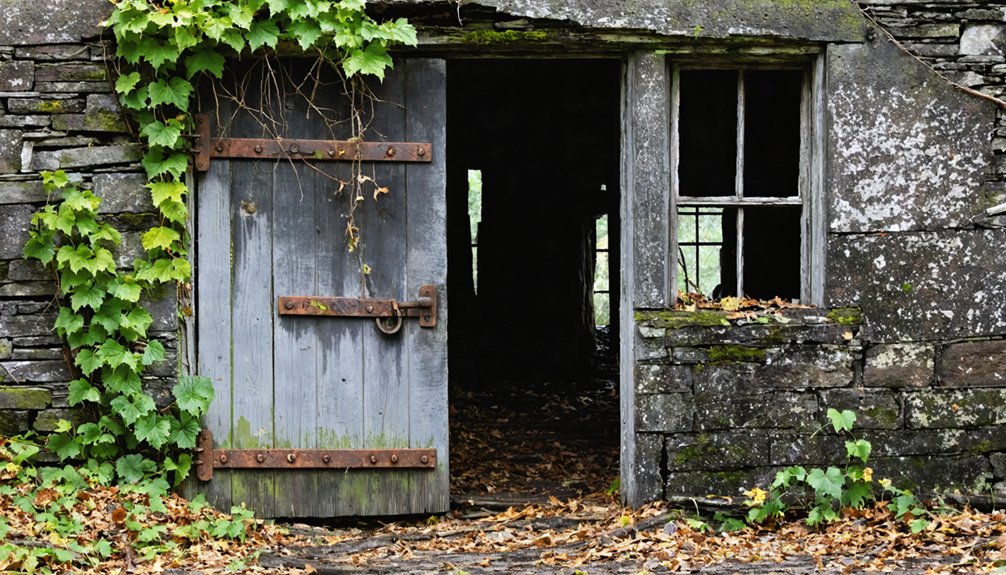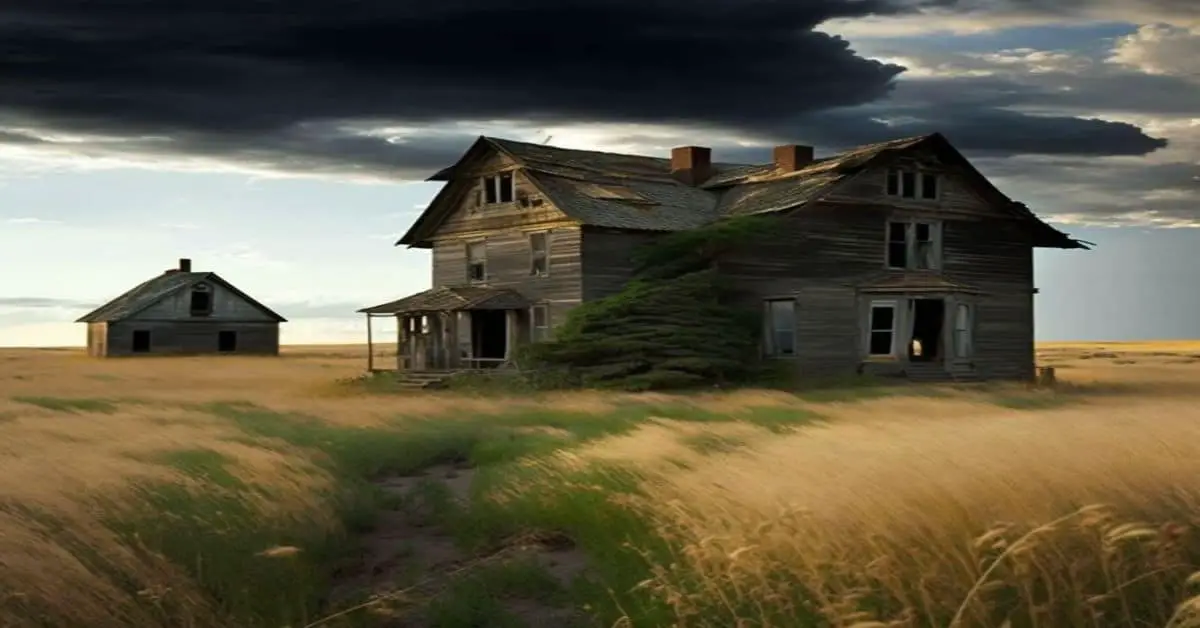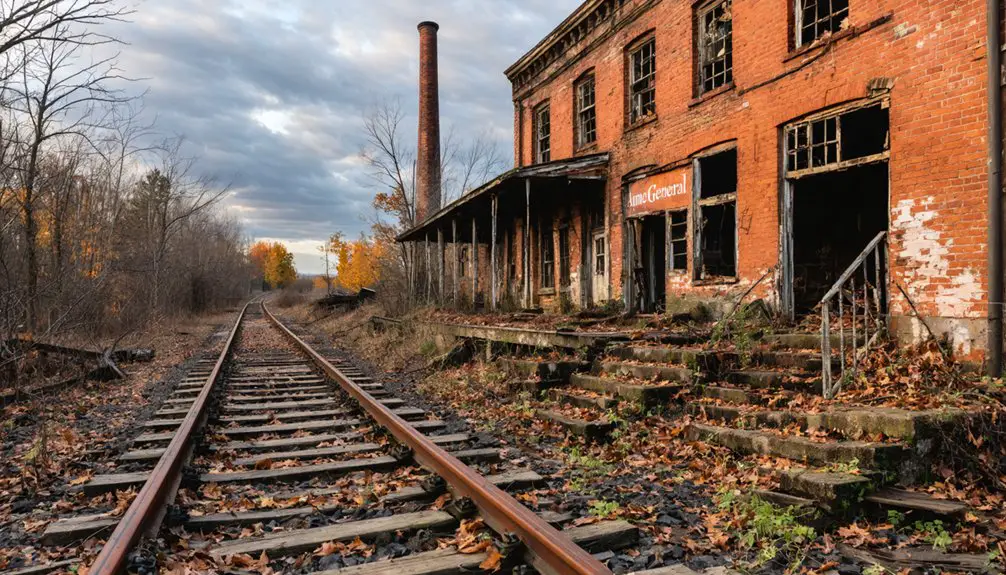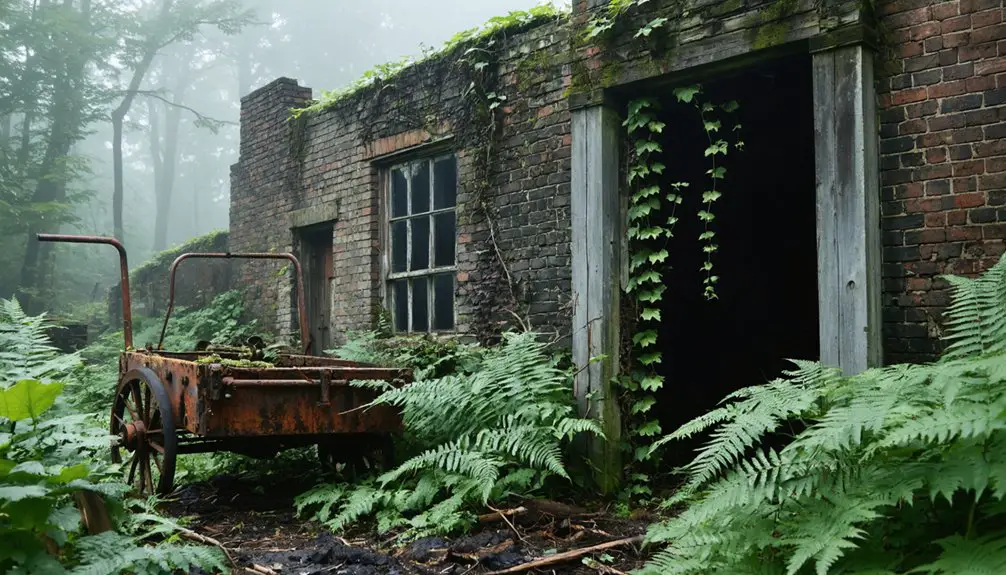You’ll find Shanktown’s haunting remains along Pennsylvania’s Ghost Town Trail, where this once-thriving coal mining settlement peaked at 800 residents in 1920. The community centered around the Lancashire No. 18 mine, where immigrant families built lives in company-owned homes until environmental hazards and mining disasters forced them to leave. By 1965, the town stood empty, its wooden buildings slowly decaying. Today, crumbling structures and local legends tell tales of America’s industrial past.
Key Takeaways
- Shanktown was a Pennsylvania anthracite mining community that emerged in the late 18th century and became abandoned by 1965.
- The Lancashire No. 18 mine explosion in 1924 killed 36 miners, contributing to the town’s eventual decline.
- The community peaked at 800 residents in 1920, featuring company-owned homes, shared water facilities, and local gathering spots.
- Environmental hazards like toxic mine drainage, sinkholes, and lethal gases from abandoned mines led to the town’s abandonment.
- Today, Shanktown’s ruins attract urban explorers and photographers, connected to the broader Ghost Town Trail system.
The Birth of a Mining Community
As Pennsylvania’s anthracite coal industry took root in the late 18th century, mining communities like Shanktown emerged from the rugged northeastern landscape.
You’d have witnessed entrepreneurs and speculators rushing to establish the infrastructure needed to extract the valuable black diamonds that lay beneath the earth.
The community origins of Shanktown reflected the era’s labor dynamics, as waves of immigrant workers settled near the mines, bringing their diverse cultures and determination to build a new life. Miners employed the traditional room-and-pillar method to extract coal from the rich anthracite seams.
Immigrant miners carved out new lives in Shanktown, their diverse heritage shaping the community as they pursued the American dream.
You’d have found a bustling town taking shape, complete with company stores, housing, and social institutions.
The arrival of the railroad transformed this once-remote location into an essential hub, connecting Shanktown to eastern markets and cementing its place in Pennsylvania’s expanding coal empire. By the 1840s, the development of coal breakers revolutionized how the town processed its anthracite, increasing both efficiency and production.
Life in Early Shanktown
Life in early Shanktown painted a vivid portrait of resilience amid harsh realities. You’d find families crowded into simple wooden frame houses, where German, Irish, and Eastern European immigrants shared their cultural traditions through community gatherings and ethnic festivals.
Despite the challenging conditions of company-owned homes with shared water facilities, these dwellings became vibrant social hubs. Much like the Leni Lenape tribe that once inhabited these lands, residents learned to live in harmony with the local environment. European diseases brought by early settlers led to devastating population losses among the native inhabitants of the region.
Your daily rhythm would’ve followed the mine shifts, with men descending underground while women tended to domestic duties and small vegetable gardens.
You’d navigate a world where church events anchored social life, and neighbors supported each other through illness and hardship.
In the evening, you might join others at the local tavern or general store, where stories of the day’s work echoed through weathered walls.
The Mining Industry’s Golden Era
As you descend into the dark shafts of Shanktown’s anthracite mines, you’d witness hundreds of coal-blackened men working ten-hour shifts, breaking coal from the mountain’s depths with picks and dynamite.
You’d see them emerge from the Hillside Colliery and other local operations, their faces streaked with coal dust after extracting thousands of tons of “black diamond” each day. These hardworking immigrant labor force shaped the backbone of America’s industrial might through their tireless work in the mines.
Coal Extraction Operations Daily
During the mining industry’s golden era, Shanktown’s Lancashire No. 18 mine buzzed with intense daily coal extraction that defined western Pennsylvania’s industrial might.
You’d find dozens of miners working 8-10 hour shifts, digging deep into the bituminous seams with a mix of hand tools and early mechanized equipment. Similar to how iron grates revolutionized anthracite ignition in 1808, technological advances transformed mining efficiency.
The daily extraction wasn’t without its challenges. You’d hear the echoes of explosives breaking coal seams, while foremen coordinated crews through hammer taps and air pipe signals. The mine’s makeshift ventilation system created dangerous working conditions for the crews.
Mining machines boosted output but brought new risks of methane ignition. Despite evolving safety measures, you’d face constant threats from rock falls, gas buildups, and equipment failures.
It’s this delicate balance between maximum production and survival that shaped Shanktown’s gritty determination to power America’s industrial revolution.
Workers’ Lives Underground
Deep beneath Shanktown’s surface, miners endured grueling 12-hour shifts in cramped tunnels where coal dust filled their lungs and dim carbide lamps cast eerie shadows on unstable rock walls. The deadly afterdamp gases lingered invisibly after fires and explosions, making rescue efforts treacherous.
You’d navigate through tight passages while watching for deadly methane gas pockets and listening for the telltale creaks of weakening support beams. Every breath you took carried the risk of black lung disease, yet you’d press on, knowing your family depended on your wages.
Underground dangers lurked at every turn – from sudden rock falls to the ever-present threat of explosions like the one that claimed 36 lives at Lancashire #18. The Barnes and Tucker Coal operation became forever marked by the devastating explosion of January 28, 1924.
Despite the constant assault on miner health, you’d form unbreakable bonds with your fellow workers, united by the shared perils of extracting “black diamonds” from Pennsylvania’s unforgiving earth.
Environmental Challenges and Disasters
If you’d ventured into Shanktown’s mines during its heyday, you’d have encountered deadly carbon monoxide and methane gases seeping through the poorly ventilated shafts, much like the lethal conditions that plagued Pennsylvania’s Rolling Mill Mine.
Above ground, the earth gradually gave way as mining operations hollowed out the terrain beneath, creating dangerous sink holes that threatened homes and businesses throughout the township. Like the historic dam break in Spartansburg, environmental catastrophes in Pennsylvania’s industrial towns often stemmed from human modifications to the landscape.
The environmental toll rippled outward, as toxic mine drainage seeped into local waterways and underground gases occasionally burst through the surface, reminding residents of the price paid for coal extraction.
Toxic Gases Underground
Underground within Shanktown’s abandoned mines, lethal gases still pose an invisible threat to this day.
You’ll find deadly methane, known as firedamp, lurking in the dark passages where it once sparked devastating explosions. The town’s most notorious disasters occurred in 1910 and 1924, when toxic gas detection methods weren’t advanced enough to prevent tragedy.
After each explosion, a more sinister threat emerged – afterdamp, a lethal mixture containing carbon monoxide that claimed countless lives.
You can imagine the desperation of rescue crews fighting against time and poisonous air to reach trapped miners. Despite implementing methane management systems and ventilation controls, Shanktown’s mines remained deadly.
The community paid dearly – nearly 2,000 Pennsylvania miners lost their lives to gas and dust explosions between 1878 and 1932.
Sinking Earth Problems
Beyond the deadly gases that plagued Shanktown’s mines, an even more visible menace haunted the town – the ground itself couldn’t hold steady. You would’ve witnessed homes cracking and foundations shifting as the earth beneath gradually gave way, a deadly reminder of the hollow chambers left by coal extraction.
The mining impacts spread across thousands of acres, creating a landscape where you’d never know when the ground might suddenly collapse.
Like many Pennsylvania coal towns, Shanktown’s ground stability became increasingly precarious as abandoned mine shafts deteriorated. You can still see evidence of this today – sunken yards, twisted sidewalks, and condemned buildings standing as silent testimony to the earth’s betrayal.
The town’s very foundation had been sacrificed to fuel America’s industrial growth.
Mining Disaster Ripple Effects
While the immediate horror of Shanktown’s 1924 Lancashire #18 mine explosion claimed 36 lives, you’d see its devastating ripples spread far beyond those initial deaths.
The disaster recovery revealed heartbreaking family losses – fathers and sons, brothers, and husbands perishing together in the darkness below ground.
You can’t separate the environmental toll from the human cost. Toxic gases and coal dust contaminated the air, while mine flooding pushed deadly pollutants into local waterways.
The community’s resilience was tested as widows struggled to support their children – some losing multiple husbands to separate mining accidents.
Beyond the immediate tragedy, you’d witness the lasting economic wounds: disrupted coal supply chains, lost wages, and intensified labor tensions that would reshape Shanktown’s social fabric for generations to come.
The Great Exodus: Why Residents Left
Since the fateful day in 1962 when a burning trash pit ignited Centralia’s underground coal seams, the town’s residents faced an impossible choice that would tear their community apart.
You’d have watched your neighbors pack up and leave as toxic gases seeped through basement walls and sinkholes threatened to swallow homes whole. Despite initial community resilience, the relentless spread of the fire beneath your feet made staying increasingly dangerous.
By 1992, the state’s eminent domain action forced your hand. You couldn’t fight both the underground inferno and the government’s evacuation orders.
The loss of your ZIP code in 2002 marked the final blow to historical preservation efforts. With plummeting property values and no economic alternatives, you’d join the exodus, leaving behind generations of memories in this once-thriving coal town.
Ghost Town Status and Decay
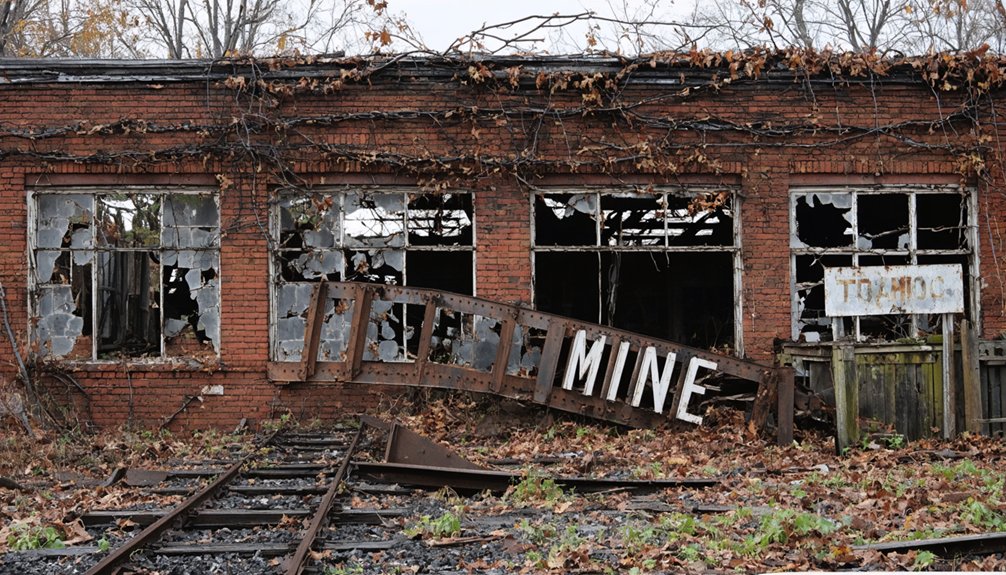
As you walk through Shanktown today, you’ll find the skeletal remains of abandoned company houses and storefronts that once bustled with coal miners and their families.
Where hundreds of residents once lived and worked, only crumbling foundations and weathered wooden structures remain, slowly being reclaimed by Pennsylvania’s persistent forest growth.
The town’s population, which peaked at over 800 in 1920, dwindled to zero by 1965, leaving behind a haunting reminder of the region’s boom-and-bust mining era.
Abandoned Buildings and Ruins
Once a bustling coal mining community, Shanktown now stands as a haunting collection of deteriorating structures that tell the story of industrial decline.
You’ll find crumbling buildings with collapsed roofs, broken windows, and vegetation reclaiming what humans left behind. Urban photography enthusiasts capture the eerie beauty of churches, schools, and homes that have surrendered to time and neglect.
The town’s industrial heart lies exposed in the ruins of old coke ovens, mine entrances, and rusted rail sidings.
While some structures beckon with architectural preservation potential, many pose serious dangers – from unstable floors to hidden mine subsidence.
You’ll notice warning signs near hazardous areas, as nature steadily dismantles these remnants of Pennsylvania’s coal mining heritage, creating an atmosphere that’s both fascinating and melancholic.
Population Decline Over Time
The stark ruins of Shanktown mirror a deeper demographic decline that has transformed this former mining hub into a shrinking community.
You’ll find a town that’s lost over 16% of its residents since 2000, when the population peaked at 735. By 2023, only 614 people called this place home.
The story you’re seeing unfold here reflects the broader fate of Pennsylvania’s post-industrial towns.
Like nearby Johnstown, which has shed 70% of its population since 1920, Shanktown faces relentless population migration as younger residents seek opportunities elsewhere.
Demographic shifts have left an aging community struggling to maintain basic services.
Each closed storefront and empty home tells the tale of a once-vibrant town fighting to hold onto its remaining residents.
Archaeological Discoveries and Remnants
While modern-day Shanktown stands largely abandoned, archaeological discoveries have revealed layers of rich history beneath its transformed landscape.
You’ll find artifact preservation challenging here, where extensive terraforming has altered original terrain features and buried significant industrial remnants.
Advanced excavation techniques have uncovered:
- Native American artifacts within nearby cave systems, suggesting prehistoric settlements predating the town
- Subsurface ruins of the 1780s Union Sawmill, now hidden beneath rail yard infill and wetlands
- Industrial tools and mechanical components near original mill race locations, though many remain inaccessible
Today, you can explore scattered remnants of 18th and 19th-century building techniques in collapsed structures, while pottery shards and metal fragments tell stories of the town’s industrial past.
The modified landscape continues to guard its secrets, with many historical treasures still waiting to be discovered.
Local Legends and Historical Tales
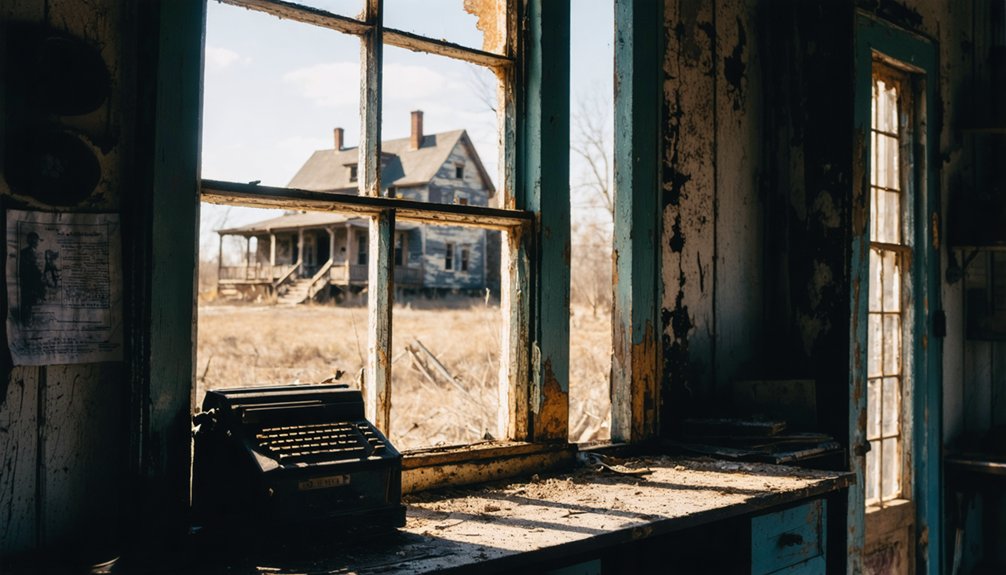
Beyond archaeological remnants, Shanktown’s rich folklore weaves through its abandoned streets and crumbling structures. Local folklore tells of a mysterious “Smoke Lady” who drifts through the fog on quiet nights, while ghost stories spread of unexplained footsteps and whispers echoing from abandoned mine shafts.
You’ll hear tales of tragic mining accidents and the souls of workers who never made it home. These stories reflect deeper community tensions, as bitter disputes divided neighbors over staying or leaving their condemned homes.
The town’s connection to American history runs deep – from Robert Morris’s early land ownership to the boom years of coal mining. Even now, former residents pass down their accounts, keeping alive both the triumphs and tragedies that shaped Shanktown’s haunting legacy.
Preservation Efforts and Legal Battles
Since falling into abandonment decades ago, Shanktown’s preservation has become entangled in complex legal battles between private landowners, local government agencies, and historical preservation groups.
You’ll find the site caught between competing interests, where legal disputes over access rights and liability concerns have complicated efforts to protect this piece of Pennsylvania’s coal mining heritage.
Current preservation strategies include:
- Limited stabilization of remaining structures through partnerships between historical societies and county parks
- Development of interpretative materials connecting Shanktown to the broader Ghost Town Trail system
- Creation of controlled access points that balance safety concerns with historical tourism
While you can’t freely explore every corner of Shanktown due to private property restrictions, local organizations continue working to preserve what remains of this monument to America’s industrial past.
Modern-Day Exploration and Tourism
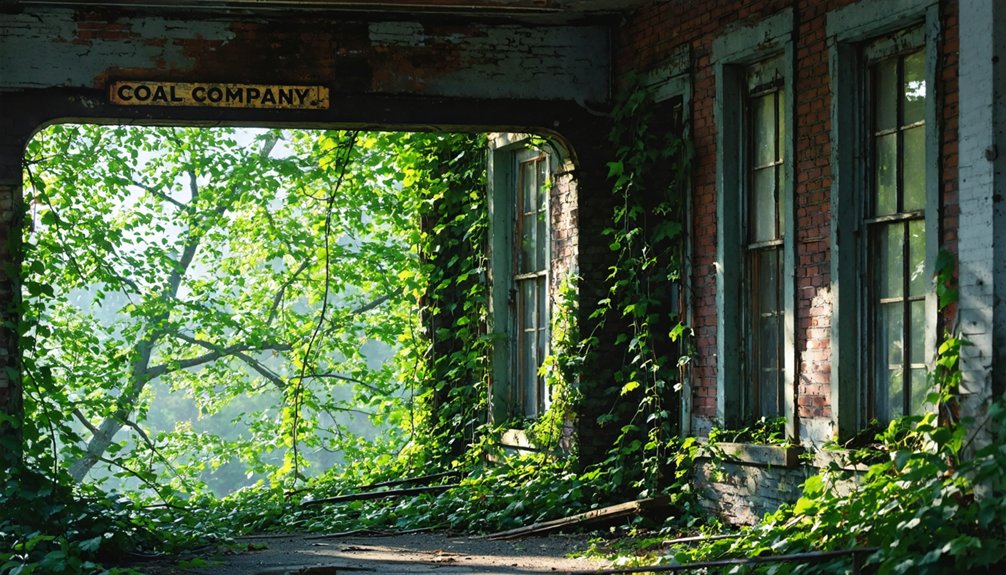
Today’s visitors to Shanktown encounter a haunting mixture of industrial ruins and nature’s reclamation, marking a stark contrast from the preservation challenges that have shaped its recent history.
You’ll find the ghost town largely accessible for urban exploration, though you’ll need to watch your step as you navigate deteriorating structures and overgrown pathways.
The site draws photographers and history enthusiasts year-round, with peak visitation during warmer months.
While there aren’t any official tours, you’re free to wander the remnants of this once-thriving community.
Steam vents and smoky fissures create an otherworldly atmosphere, though you’ll want to heed warning signs about unstable ground and toxic gases.
Remember to document your discoveries respectfully, as the site’s historical significance continues to draw curious explorers from across the country.
Frequently Asked Questions
Are There Any Remaining Descendants of Shanktown Residents Still Living Nearby?
You’ll find descendant connections remain active in nearby Pennsylvania coal towns, where family histories and oral traditions keep Shanktown’s legacy alive through scattered relatives who’ve stayed in the region.
What Specific Mining Techniques and Equipment Were Used in Shanktown’s Mines?
Miners managed massive operations using pickaxes and primitive explosives in room-and-pillar layouts. You’ll find they relied on hand tools, Joy loaders, and conveyor belts to extract coal efficiently underground.
How Did Mail and Supplies Reach Shanktown During Its Most Remote Periods?
You’d find your mail and supplies arriving by company trains on coal-mining routes, while rugged informal networks of miners carried letters along mountain trails when official delivery services couldn’t reach these remote parts.
Did Any Notable Crimes or Unsolved Mysteries Occur in Shanktown?
With a population under 200, you won’t find documented unsolved crimes or ghost sightings in historical records. Mining towns like this typically saw common disputes, but no notable mysteries emerged.
What Indigenous Peoples Inhabited the Shanktown Area Before Mining Began?
You’ll find the Lenape people were the primary inhabitants, with their rich indigenous history centered on hunting and farming. The Susquehannock, Shawnee, and Iroquois also held cultural significance in this area.
References
- https://www.youtube.com/watch?v=Qj5LjacccJ0
- https://pabucketlist.com/the-rise-and-fall-of-centralia-pas-toxic-ghost-town/
- https://en.wikipedia.org/wiki/Centralia
- https://en.wikipedia.org/wiki/List_of_ghost_towns_in_Pennsylvania
- https://www.youtube.com/watch?v=fm3wxSOqlYM
- https://openrivers.lib.umn.edu/article/anthracite-heritage-landscape-memory-and-the-environment/
- https://www.pa.gov/agencies/dep/programs-and-services/mining/bureau-of-mining-programs/pa-mining-history.html
- https://en.wikipedia.org/wiki/History_of_anthracite_coal_mining_in_Pennsylvania
- https://www.iup.edu/library/departments/archives/coal/people-lives-stories/ernest-life-in-a-mining-town.html
- https://npshistory.com/publications/aih-sw-pa/coal-coke.pdf
